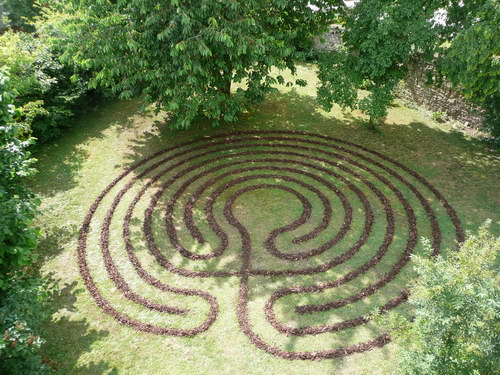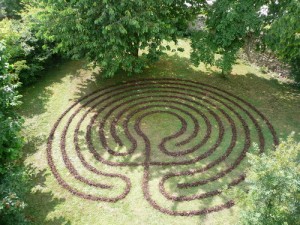by Erwin
How to do that should be clear theoretically. It was posted earlier on this blog. But if you do not remember any more or would like to look once again: the posts below are recommended.
The labyrinth here has a dimension between axes of 50 cm, the center should get a diameter of 2 m, the central square also has sides of 2 m length, the whole diameter will thereby be 9 m.
We first stake off the 5 mean points on which later literally everything turns.
 The 5 mean points
The 5 mean points

The marked 5 points
Then the internal and a little more complicated parts are “built”: strewn with bark mulch. These are all parts which are lying within a triangle formed by the 5 marked points.
Thus a cake piece is built through the the inner ways of the labyrinth which are all specified by 4 different centers and different radii.
It is advisable to start with the internal cross, the only straight lines in the labyrinth; and then to form the remaining bends.
Doing so, the basis is created for the 8 following in parallel distance running arcs.

The inner arcs
 The inner arcs
The inner arcs
Now it is only a matter of finishing the remaining bends around the centre in the middle.
Every arc has the same center and a 50 cm bigger radius than the preceding arc, if one works from the inside outwardly.
The arcs are running from the right side completely to the left and vice versa.
For this work many people can be occupied. One could put on even 8 curves at the same time. Or work from two sides as it was done here.

The complete labyrinth
The exact dimensions of the used radii can be taken from the following drawing, also the other necessary measures.
Here you can see/print/store/copy the drawing as a PDF file:
http://bloggermymaze.files.wordpress.com/2009/08/knidos_50_muster_alles.pdf

Here the dimension between axes of 50 cm was used. A radius of 50 cm for the smallest arc and for the biggest one a radius of 4.50 m.
Therefore the whole diameter amounts to 9 m. For the size of the center the 4-fold dimension between axes was applied.
Thus the diameter of the center is the same as the side length of the square formed by the 4 inflection points.
The labyrinth is scalable in the size.
If one wants to build, e.g., one with a dimension between axes of 1 m (what results 18 m for the whole diameter), one multiplies all measurements by 2.









